Just as you step into the vibrant streets of San Miguel de Allende during Día de Muertos, the aroma of freshly baked pan de muerto fills the air. This iconic bread, with its soft texture and symbolic design, is more than a treat—it’s a cherished tradition that honors loved ones who have passed. In San Miguel de Allende, you’ll find this delicacy crafted with care, blending local flavors with centuries-old customs. Discover how this bread connects you to the heart of Mexican culture and why it’s a must-try during your visit.
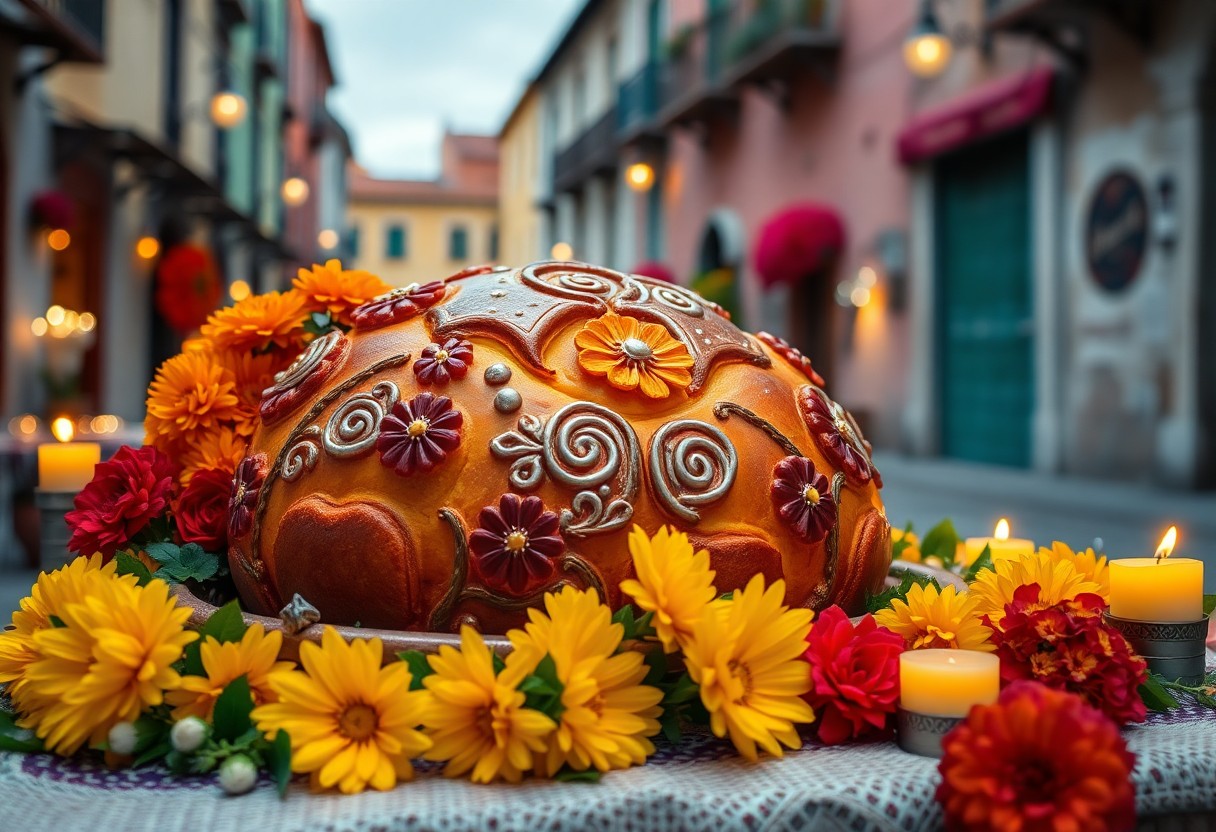
The Origins of Pan de Muerto
A symbol of Mexico’s rich cultural heritage, pan de muerto traces its roots to pre-Hispanic traditions. The Aztecs once offered bread made from amaranth to honor their gods. With the arrival of Spanish colonizers, wheat flour and European baking techniques were introduced, blending indigenous and colonial customs. Over time, this fusion evolved into the iconic bread you see today, deeply tied to Día de Muertos. In San Miguel de Allende, this tradition thrives, with local bakeries crafting pan de muerto as both a delicious treat and a meaningful offering for the departed.
How Pan de Muerto Has Changed Over Time
While pan de muerto has always been a staple of Día de Muertos, its recipe and design have evolved significantly. Originally, it was a simple bread made with basic ingredients like flour and water. Over time, bakers in San Miguel de Allende and across Mexico began adding flavors such as orange blossom water, anise, and butter, enhancing its taste and texture. The iconic crossed bone design, symbolizing the cycle of life and death, became a defining feature. Today, you can find modern twists, like chocolate or fruit-filled versions, while still honoring its traditional roots.
Regional Variations of Pan de Muerto Across Mexico
Before you explore the regional variations of pan de muerto, it’s important to understand how this iconic bread reflects Mexico’s diverse culinary traditions. Each region adds its unique twist, creating a rich tapestry of flavors and designs that honor the Day of the Dead in distinct ways.
Mexico City and Central Mexico
There’s a reason the classic pan de muerto from Mexico City and Central Mexico is widely recognized. This version is flavored with orange zest or orange blossom water, topped with the iconic crossed bone design, and dusted with sugar. It’s a staple on ofrendas and a favorite for its balanced sweetness and symbolic meaning.
Oaxaca
Little compares to the intricate beauty of Oaxacan pan de muerto. Known for its sweet and buttery taste, this version often features elaborate decorative patterns on top, symbolizing the delicate balance between life and death. It’s a visual and culinary masterpiece.
Mexico’s Oaxacan pan de muerto stands out for its artistry. The bread’s designs often include flowers, crosses, or other symbols, making it a centerpiece on ofrendas. Its rich flavor and cultural significance make it a must-try during your Day of the Dead celebrations.
Michoacán
With its unique shapes, Michoacán’s pan de muerto often takes the form of human figures called animitas, representing the souls of the departed. This variation is deeply symbolic, connecting the living with their ancestors in a tangible way.
Michoacn’s pan de muerto is more than just bread—it’s a tribute to the departed. The animitas are carefully crafted, often adorned with colorful decorations, and placed on ofrendas to honor loved ones. This tradition highlights the region’s deep respect for its cultural heritage.
Yucatán
Assuming you’ve never tried Yucatán’s pan de muerto, you’re in for a treat. This version is flavored with anise and covered in a sweet red glaze, giving it a distinct appearance and flavor. It’s a vibrant addition to any ofrenda.
Mexico’s Yucatán region offers a pan de muerto that’s as colorful as its culture. The red glaze symbolizes life and vitality, while the anise adds a unique twist to the traditional recipe. It’s a flavorful reminder of the region’s rich traditions.
Guanajuato
An imperative part of Guanajuato’s Day of the Dead celebrations is its pan de muerto, often made with piloncillo (unrefined cane sugar). This gives the bread a richer, denser flavor, making it a standout among regional variations.
City bakeries in Guanajuato take pride in their pan de muerto, blending traditional techniques with local ingredients. The use of piloncillo adds a depth of flavor that reflects the region’s culinary heritage, making it a must-try during your visit to San Miguel de Allende.
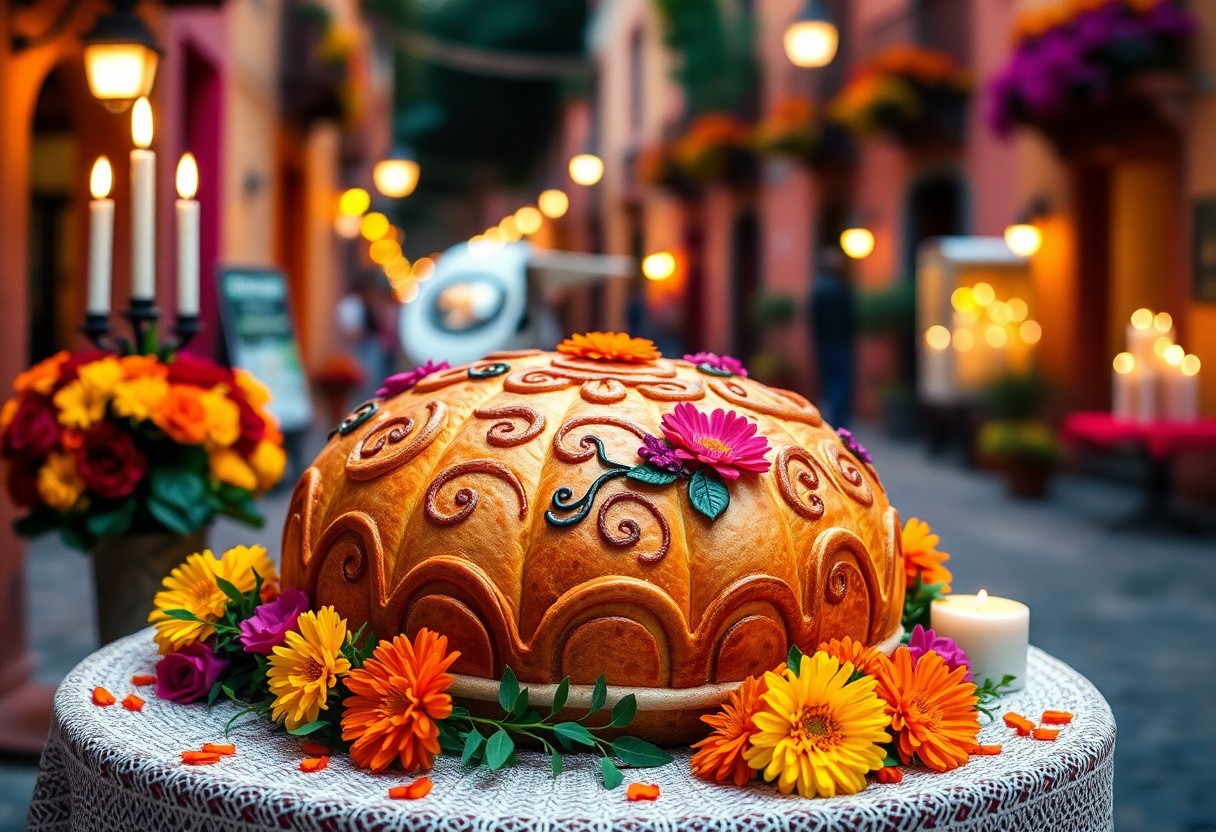
The Role of Pan de Muerto in Día de Muertos and Ofrendas
Your understanding of Día de Muertos in San Miguel de Allende deepens when you recognize the significance of pan de muerto in ofrendas. This bread, often flavored with orange blossom water or anise, is placed on altars to honor deceased loved ones. Its circular shape symbolizes the cycle of life and death, while the crossed bones on top represent the connection between the living and the departed. By offering pan de muerto, you nourish the spirits during their visit, creating a bridge between past and present. It’s a powerful tradition that keeps memories alive.
Making Pan de Muerto: A Step-by-Step Guide
All you need to make authentic Pan de Muerto is a few simple ingredients and a bit of patience. This traditional bread, deeply rooted in the culture of San Miguel de Allende, is a meaningful way to connect with Día de Muertos traditions. Below, we break down the process into clear steps, highlighting key details to ensure your bread turns out perfect.
Pan de Muerto Recipe Guide
| Ingredients | Steps |
| 4 cups flour | Mix flour, yeast, sugar, and salt in a bowl. |
| 1/2 cup sugar | Add warm milk, eggs, and orange zest, then knead until smooth. |
| 1/2 cup butter | Incorporate softened butter and knead for 10 minutes. |
| 1/4 cup orange zest | Let the dough rise for 1-2 hours until doubled in size. |
| 1/4 cup warm milk | Shape the dough into rounds and add bone-shaped decorations. |
| 2 eggs | Bake at 350°F (175°C) for 20-25 minutes until golden brown. |
| 1 packet yeast | Brush with melted butter and dust with sugar before serving. |
Important Notes: Ensure your yeast is fresh to avoid dough that doesn’t rise. Be cautious when handling hot pans and ovens. The orange zest and butter are key to achieving the authentic flavor of Pan de Muerto. Enjoy this bread as part of your Día de Muertos celebration in San Miguel de Allende, where tradition and taste come together.
Tips for Enjoying Pan de Muerto in San Miguel de Allende
For the best experience with pan de muerto in San Miguel de Allende, follow these tips:
- Visit local bakeries early in the day to ensure you get the freshest bread, as it often sells out quickly during the Día de Muertos season.
- Pair your pan de muerto with a cup of hot chocolate or atole, a traditional Mexican drink, to enhance its flavors.
- Explore regional variations, such as those flavored with orange blossom water or anise, to appreciate the diversity of this iconic bread.
- Respect the cultural significance by learning about its role in ofrendas and how it honors the deceased.
After enjoying your pan de muerto, take time to reflect on its deep connection to Mexican traditions and the celebration of life and death.
Hence, Pan de Muerto stands as a delicious symbol of tradition in San Miguel de Allende, blending history, culture, and flavor into a single pastry. You can experience its significance during Día de Muertos, where it serves as both an offering and a reminder of the connection between life and death. By exploring its regional variations and enjoying its unique taste, you immerse yourself in the rich heritage of this Mexican celebration. In San Miguel de Allende, Pan de Muerto not only honors the past but also invites you to savor the traditions that continue to shape its vibrant culture.
FAQ
What is the significance of Pan de Muerto in San Miguel de Allende?
Pan de Muerto holds deep cultural significance in San Miguel de Allende, especially during Día de Muertos. It is a traditional pastry used as an offering on ofrendas to honor deceased loved ones. The bread symbolizes the cycle of life and death and connects the living with the spirits of the departed.
How is Pan de Muerto in San Miguel de Allende different from other regions in Mexico?
In San Miguel de Allende, Pan de Muerto often incorporates regional ingredients like piloncillo (unrefined cane sugar), giving it a richer and denser flavor. The bread typically follows the classic design with crossed bones on top, but local bakers may add unique touches that reflect the traditions of Guanajuato.
Where can I find the best Pan de Muerto in San Miguel de Allende?
The best Pan de Muerto in San Miguel de Allende can be found at local bakeries and markets, especially during the Día de Muertos season. Many bakeries offer traditional and regional variations, allowing visitors to experience the authentic flavors and cultural heritage of the area.
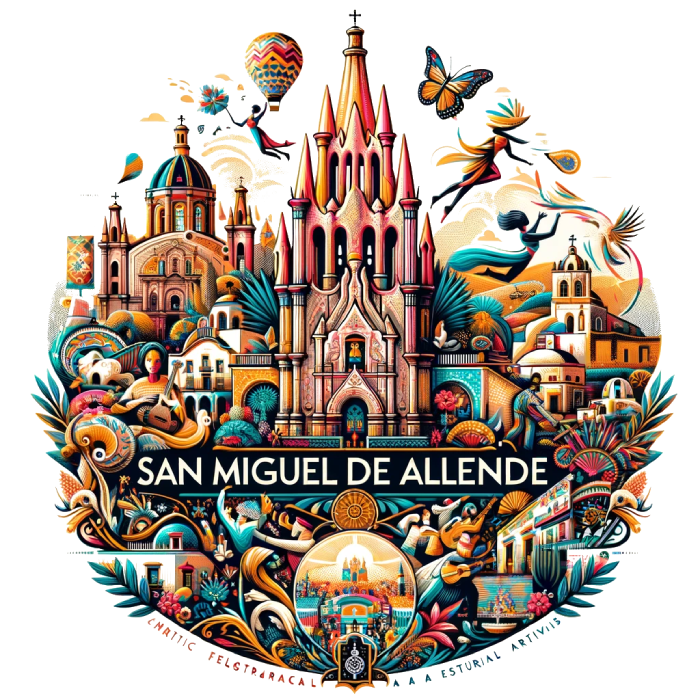


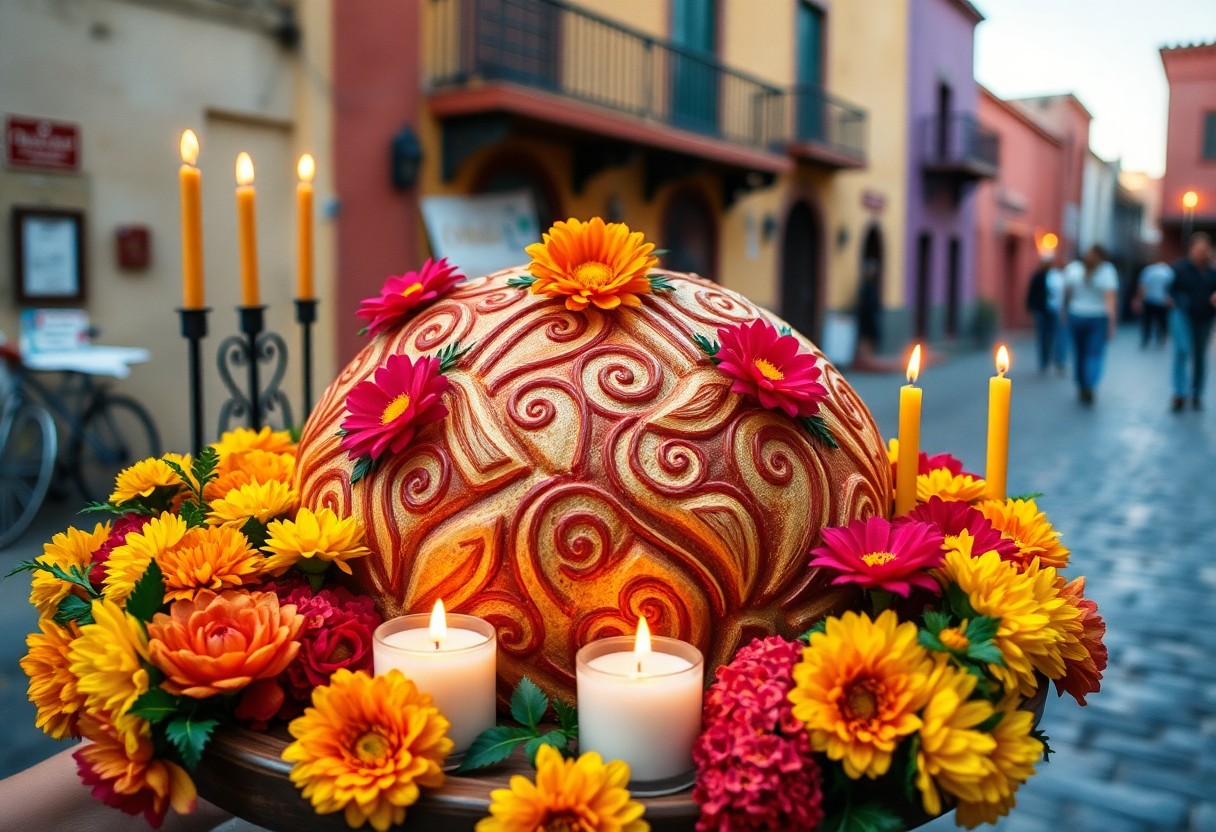
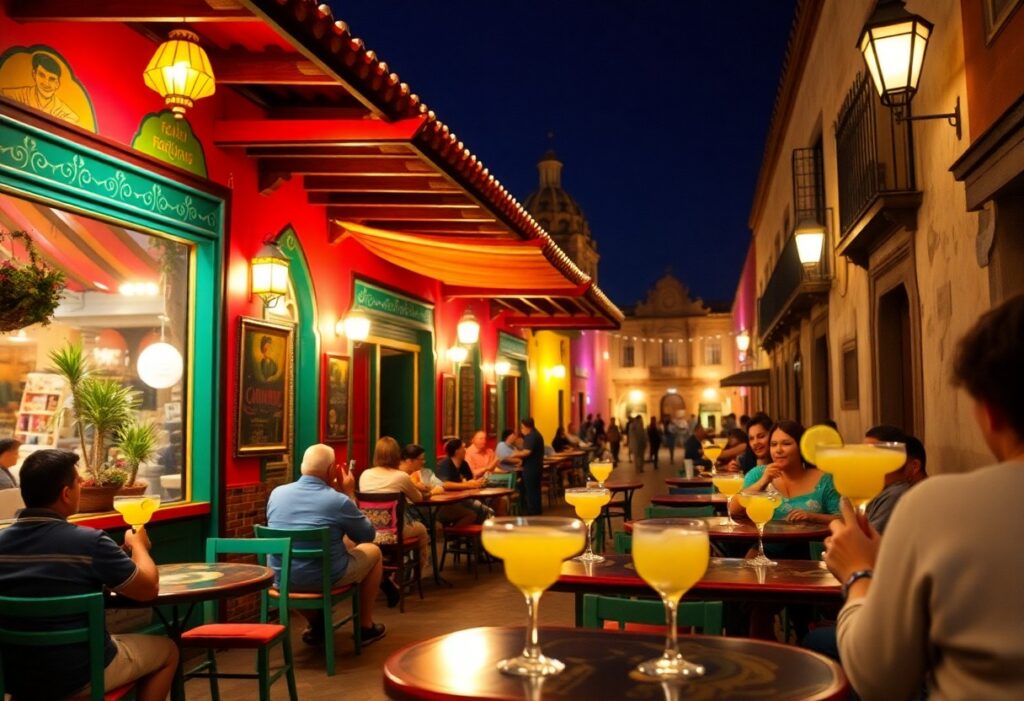
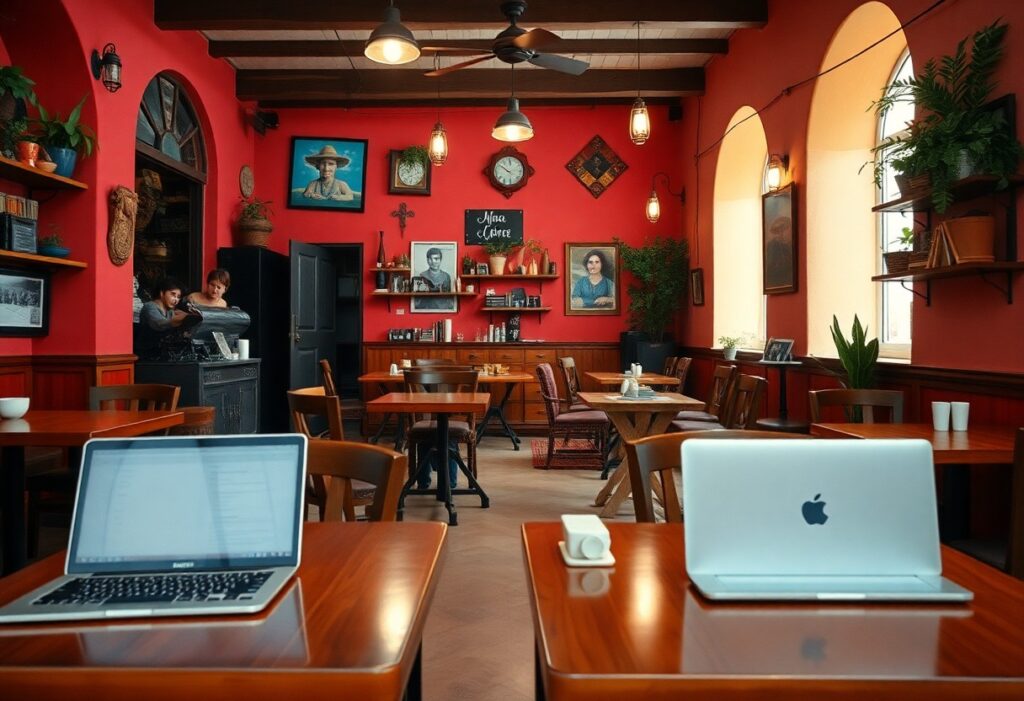
The depiction of San Miguel de Allende during Día de Muertos and the evocative description of pan de muerto stir a multitude of thoughts about how culinary traditions can serve as an intimate bridge to our cultural identities and histories. It’s fascinating to consider how this simple bread isn’t just a culinary delight but a vessel for memory and remembrance. Its evolution from ancient Aztec offerings to contemporary family altars captures a broader narrative of cultural adaptation and resilience.
Your reflections on the significance of pan de muerto truly resonate with the heart of what makes Día de Muertos such a profound experience. The way culinary traditions embody cultural identity is something that often goes unrecognized until we start to peel back the layers.
You’ve touched on something deeply resonant about how food weaves through our lives, especially during significant cultural celebrations like Día de Muertos. The way pan de muerto is more than just a sweet bread made for the occasion really highlights our connection to the past. This isn’t just about tasting something delicious; it’s about nurturing ties to memories and honoring those who came before us.
You’ve really hit the nail on the head with your thoughts on pan de muerto. It’s fascinating how this beloved bread becomes a vessel for remembering and connecting with those we’ve lost. When families gather to make and share it, there’s an unspoken understanding that it’s not just about the flavor or the ingredients; it’s about the stories and love that come with each bite.
Your description of Día de Muertos in San Miguel de Allende truly captures the essence of this beautiful tradition. Pan de muerto is not just a culinary delight; it represents a cultural bridge that connects generations and honors those we’ve lost. When I think about my own experiences during this time, the smell of pan de muerto takes me back to family gatherings where stories were shared alongside the bread. Each bite is infused with memories, acting as a reminder of the importance of honoring our ancestors.
You’re so right about pan de muerto serving as a cultural bridge. It’s fascinating how something as simple as bread can weave together generations. That smell you mentioned—it’s almost like a time machine, bringing you back to family gatherings where laughter and stories flowed just as freely as the hot chocolate.
I completely resonate with what you said about pan de muerto acting as a cultural bridge. There’s something so grounding about those familiar flavors and scents. It’s interesting how food can evoke such vivid memories, isn’t it? For me, the smell of pan de muerto takes me back to my grandmother’s kitchen, where she’d always have a batch freshly baked just in time for Día de los Muertos.
It’s really fascinating how food can transport us to specific moments in our lives, isn’t it? The smell of pan de muerto seems to have that power for so many people. It’s like a time capsule that captures not just the flavors, but also the warmth and love that comes from those family gatherings. Your memory of your grandmother’s kitchen resonates with many who have a similar experience tied to traditional dishes.
You’re so right about how food acts as a time capsule, isn’t it? I often find that certain scents can trigger an avalanche of memories, especially when it comes to dishes tied to family traditions. For instance, when I smell freshly baked bread, it transports me back to cozy Sunday mornings at my aunt’s house, where the aroma filled the air and we would gather around the table for brunch.
It’s so moving to hear how pan de muerto is intertwined with your memories of your grandmother’s kitchen. Food really does have this magical ability to transport us back in time, connecting us to moments and people we cherish.
I appreciate your thoughts on pan de muerto and its connection to cherished memories. It’s fascinating how food can weave into our personal narratives, acting almost like a time capsule. For me, my grandmother’s kitchen was filled with not just the aromas of baking bread, but also the warmth of her laughter and stories from her childhood.
Your reflections on pan de muerto really resonate with me. It’s incredible how food can serve as a tangible connection to our loved ones, isn’t it? I often find that during the Día de Muertos celebrations, every shared meal offers more than just flavor; it carries stories and traditions that have been passed down through generations.
I completely agree with you—there’s something so profound about the way food acts as a bridge between our past and present. During Día de Muertos, when we gather around the altar and share those special dishes, it’s like we’re inviting our loved ones back into our lives, even if just for a moment.
It’s interesting how food really can weave such a rich tapestry of memories and emotions, isn’t it? When we sit down to share pan de muerto, it’s not just about satisfying hunger; it’s like every bite is steeped in the stories of those who came before us. I remember my first Día de Muertos celebration where we shared a huge loaf, and my abuela talked about her own memories of making it with her mother. The way she described the careful shaping of the dough felt more like an art form than a cooking process.
I really appreciate you sharing your thoughts on pan de muerto. There’s something so grounding about how food ties us to our roots and to each other, especially during Día de Muertos. It’s like each bite transports us through time, connecting us with the memories of those we’ve lost and the stories they’ve shared.
Your reflections really resonate with me. The way you describe pan de muerto as a vessel for memory and connection is spot on. It’s fascinating how something as simple as bread can hold so much significance. Each family has its own unique stories tied to this tradition, marking significant moments shared around the table.
I appreciate how you’ve articulated the significance of pan de muerto during Día de Muertos. It’s interesting to think about how such a simple bread can stir up a vast ocean of memories and forge connections across generations. Each family might have its unique way of preparing pan de muerto, perhaps with a special recipe passed down for years, and that personal touch adds layers to the meaning behind the bread.
Your exploration of pan de muerto and its significance during Día de Muertos resonates deeply with me. As someone who has spent time in Mexico, I can appreciate how the sensory experiences tied to food like pan de muerto can anchor us in cultural traditions. The bread seems to embody a delicate balance between memory and celebration, an edible representation of the lineage and ancestral connections that Día de Muertos seeks to honor.
It’s wonderful to hear how your experiences in Mexico have shaped your understanding of pan de muerto and its role in Día de Muertos. There’s something truly special about the way food can connect us to our roots, don’t you think? That combination of flavor, aroma, and texture becomes a gateway to memories—both personal and collective.
You’re so right about how food can anchor us to our history and culture. I’ve had my own experiences where the taste of a dish took me back to family gatherings and celebrations, almost like a time capsule of emotions and memories.
It’s heartening to hear that my exploration of pan de muerto struck a chord with you. The way food weaves itself into the fabric of cultural traditions is truly fascinating, isn’t it? When you mention how the bread embodies that delicate balance between memory and celebration, it brings to mind how food can serve as a bridge connecting our past, present, and future.
It’s great to hear your thoughts on pan de muerto and its role in Día de Muertos. You really captured how this particular bread is more than just a treat; it carries such weight in terms of tradition and memory. The way something as simple as food can tie us to our roots is truly fascinating.
Reading about pan de muerto brings back my own memories of celebrating Día de Muertos in Mexico. The way this bread is crafted truly is a testament to the blending of cultures. I remember the first time I had it—its delicate sweetness complemented by the rich symbolism of remembrance made it a deeply moving experience.
Your memories of Día de Muertos hit home. Pan de muerto is astonishing, right? It’s almost like a sweet little portal to another world—one where the aroma of fresh bread mingles with laughter and memories. I still remember the first time I tried it, too. I was convinced I needed a degree in pastry arts after one bite; I could almost hear the bread whispering, “You will love and remember.”
It’s fascinating how pan de muerto embodies such a rich tapestry of history and culture. Thinking about its origins, it really makes me appreciate how food connects us to the past. The blend of pre-Hispanic traditions with Spanish influences is a beautiful example of how cultures evolve together. I remember trying pan de muerto for the first time in a small café in San Miguel de Allende—there was something so comforting about its soft texture and slightly sweet taste. It felt like more than just a treat; it was a way to connect with the spirit of the celebration.
You’ve captured something truly special about pan de muerto. It is such a beautiful reflection of the layers of history that make up Mexican culture. When we bite into that soft, sweet bread, we’re not just tasting ingredients; we’re connecting with generations of tradition. The way you described your experience in San Miguel de Allende highlights how food can create a sense of belonging, transcending time and place.
It’s wonderful to hear about your experience with pan de muerto in San Miguel de Allende. That feeling of comfort you describe is an integral part of what makes traditional foods so special. They often carry the weight of generations, acting as vessels for stories and memories that connect us to our ancestors.
You captured the essence of traditional foods beautifully. There’s something magical about how a simple dish can evoke such rich memories. In San Miguel de Allende, pan de muerto isn’t just a treat; it’s a way to feel connected to our loved ones who have passed. When I took my first bite, I was struck not just by the flavor, but by the stories shared around the table—like my grandmother’s memories of baking with her mother. Every ingredient carries whispers of the past, and when I enjoy it, it feels like I’m part of that ongoing conversation. It’s fascinating how food can be this bridge between generations, isn’t it? Have you had a similar experience with a dish that ties you back to your own roots?
I completely resonate with your thoughts on how traditional foods serve as conduits for cherished memories. It’s beautiful to think about how something as simple as pan de muerto can manifest deep connections to our ancestors. I’ve had a similar experience with my grandmother’s tamales. The process of making them was almost sacred; she would guide me through each step, sharing stories of her childhood and the women in our family who came before her.
You hit the nail on the head with that thought about traditional foods being vessels for stories and memories. There’s something almost magical about how a simple piece of bread can transport you back in time, isn’t there? When I had pan de muerto in San Miguel de Allende, it felt like I was tasting not just the bread but the whole culture wrapped around it. Each bite carries layers of history, family gatherings, and rituals that have been passed down through the years.
“Gracias por compartir tus pensamientos; si te gustaría explorar más sobre la rica tradición de pan de muerto y cómo prepararlo, te invito a descubrir nuestra guía aquí.”
https://fallinginlovewithsanmiguel.com/book-flight
Your vivid description of the sights and smells of San Miguel de Allende during Día de Muertos captured my imagination. It’s a reminder of how food transcends mere sustenance to become a vessel for cultural connection and memory. The evolution of pan de muerto, as you pointed out, highlights a beautiful blend of pre-Hispanic traditions and colonial influences. This intertwining of histories is a living testament to the resilience and adaptability of culture, echoing how communities can create something uniquely meaningful from diverse origins.
I appreciate your thoughts on the sights and smells of San Miguel de Allende during Día de Muertos. It’s fascinating how food, especially something like pan de muerto, can carry such rich narratives of cultural identity and history. When we look at its evolution, it’s clear that every ingredient and method reflects layers of influence—from ancient customs to Spanish colonization.
It’s interesting to think about how food can serve as a cultural anchor, isn’t it? Pan de muerto is such a beautiful representation of that. Each ingredient doesn’t just contribute to flavor; it’s almost like a storytelling element, connecting us to the past—like the sugar representing the sweetness of life and the shaping of the bread mirroring the cycle of life and death.
You bring up such a thoughtful point about food as a cultural anchor. Pan de muerto is a fascinating example, and I love the way you describe its ingredients as storytelling elements. Each bite is truly infused with meaning, linking us to traditions that have been passed down through generations. The sugar symbolizing the sweetness of life is spot on—it’s a reminder that even in the face of death, there are moments of joy and celebration to be embraced.
“Absolutely, food truly weaves together our stories and heritage. If you’re curious to explore more cultural culinary traditions, check out this link for some delicious insights!”
https://fallinginlovewithsanmiguel.com/tours-and-excursions
It’s wonderful to hear that my description resonated with you. San Miguel de Allende indeed comes alive during Día de Muertos in a way that engages all the senses, doesn’t it? The vibrant colors and unique aromas mingle in the air, each contributing to a tapestry of memory and meaning that is hard to capture in words alone. The way food connects us to our roots is often understated, but when you experience the warmth of pan de muerto or the festive atmosphere, it becomes clear just how powerful these traditions can be.
You really captured the essence of Día de Muertos in San Miguel de Allende. The way the colors and scents intertwine is like a living art piece, isn’t it? There’s something special about how food connects us, especially with pan de muerto. It’s more than just a treat; it’s a warm reminder of home, family, and the stories we pass down.
I love your description of San Miguel de Allende during Día de Muertos—there’s something magical about the way the celebration brings the community together. Pan de muerto, with its rich history and symbolism, not only represents the connection to loved ones who have passed but also showcases the beautiful blending of cultures in Mexico.
It’s great to hear your thoughts on San Miguel de Allende and Día de Muertos. There’s really something special about how the celebration transcends mere remembrance; it feels like a bridge connecting us with those we’ve lost. Growing up witnessing these colorful gatherings, I always appreciated how families come together to honor their loved ones.
Your observation captures the essence of Día de Muertos beautifully. The way communities come together in San Miguel de Allende during this time is truly special. It’s a wonderful blend of remembrance and celebration, where the streets fill with life, color, and laughter.
Your vivid description of San Miguel de Allende during Día de Muertos truly captures the essence of this unique celebration and the profound relationships we maintain with our ancestors through tradition. Pan de muerto is indeed more than just a delightful treat; it’s a tangible connection to our past, a moment of remembrance infused with flavor and ritual.
It’s so true—Día de Muertos really has a way of weaving past and present together, doesn’t it? The atmosphere in San Miguel de Allende during this time is electric, and you can almost feel the spirits of our loved ones joining in the celebration.
You bring up an interesting perspective on pan de muerto and its significance during Día de Muertos. It’s true that this bread goes beyond being a simple treat; it’s deeply intertwined with the rituals and memories we hold dear. While the flavors and aromas evoke nostalgia, the shape and decoration of pan de muerto also reflect history and meaning. Each element, from the sugar coating to the bone-like shapes, carries symbolic weight that connects us to those who have passed.
Your vivid description of the vibrant streets of San Miguel de Allende during Día de Muertos truly captures the essence of this unique celebration. I find it fascinating how pan de muerto has transcended its role as merely a delicious bread; it serves as a conduit between the living and the departed. The act of preparing and sharing this special bread involves not only the careful craftsmanship handed down through generations but also a deep emotional connection—one that goes beyond food.
I love how pan de muerto embodies such a rich blend of history and meaning. It’s fascinating to think about how this bread evolved from ancient offerings to a staple in modern celebrations of Día de Muertos. I remember my first experience tasting it in San Miguel de Allende during this time—I could really feel the connection to the past and the honoring of ancestors.
It’s so great to hear about your experience with pan de muerto, especially in such a vibrant place like San Miguel de Allende. There’s something truly special about being in a location that celebrates Día de Muertos with so much life and color, isn’t there? Each bite of that sweet bread carries not just flavor, but layers of meaning and history that are palpable when you’re immersed in the atmosphere.
It’s wonderful to hear about your experience in San Miguel de Allende. That city has such a vibrant celebration of Día de Muertos, blending tradition and contemporary cultural expression. Pan de muerto really does serve as a bridge, linking us to both our ancestors and the community’s shared history.
I love how you’ve captured the essence of pan de muerto and its significance during Día de Muertos! Every time I walk through the streets of San Miguel de Allende around this time, I’m not just drawn to the smell of the bread, but also to the vibrant altars adorned with marigolds and photos of loved ones. It’s such a beautiful blend of remembrance and celebration.
You’ve really nailed the feeling of walking through San Miguel de Allende during Día de Muertos. The aromas, the sights, they all come together in a way that’s hard to describe unless you’ve experienced it firsthand. The pan de muerto, with its unique shape and flavor, isn’t just another bread; it’s a message, a connection that transcends the ordinary. It’s interesting to think about how food carries meaning in rituals like this. It’s not just sustenance; it’s a symbol of our relationships with those we’ve lost and a way to honor their presence in our lives.
¡Me alegra que lo sientas así! Si quieres profundizar en las tradiciones de Día de Muertos y descubrir recetas auténticas de pan de muerto, te invito a explorar este enlace.
https://fallinginlovewithsanmiguel.com/book-flight
Reading your post about pan de muerto has brought back such fond memories of my own experiences during Día de Muertos in Mexico. The cultural significance of this bread is truly profound. It’s fascinating how something as simple as baked bread can carry the weight of history and connection to our ancestors.
I love how you’ve captured the essence of Día de Muertos and the integral role pan de muerto plays in the celebrations. There’s something so beautiful about how food can create a connection between the past and the future—a tangible reminder of those we’ve lost. The evolution of pan de muerto from ancient traditions to its current form is a perfect example of cultural resilience and adaptation, showing how history shapes the present.
The way you described pan de muerto really encapsulates the heart of Día de Muertos. I remember my first encounter with this bread in San Miguel de Allende—how the warm, sweet aroma wrapped around me, making me feel both nostalgic and connected to something much greater than myself. It’s fascinating how this bread embodies that fusion of ancient traditions and colonial influences, which is a reminder of how cultural identities are constantly evolving.
It sounds like that first taste of pan de muerto was quite a meaningful experience for you, and it’s amazing how food can evoke such deep connections. In many ways, this bread serves as a tangible link to our past, blending pre-Hispanic traditions with post-colonial influences, which is quite telling of Mexican culture as a whole.
I really appreciate how you highlighted the cultural significance of pan de muerto! The way this bread symbolizes the connection between the past and present during Día de Muertos always fascinates me. During my last visit to San Miguel, I tried pan de muerto from a local bakery—each bite was infused with tradition, and I felt a deeper connection to the community and its history. It’s interesting to think about how such culinary traditions not only nourish us physically but also spiritually, as they invite us to honor those we’ve lost. Have you tried any variations of pan de muerto? Some bakeries experiment with flavors like chocolate or orange zest, which adds a unique twist to this beautiful tradition!